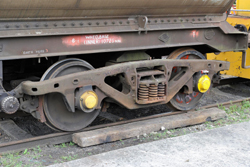Reinventing the wheel
With advances in rail technology, concerns for the environment and the rising importance of efficient public transport, the rail industry in Europe is seeing a turnaround. Faster and more comfortable trains are making rail transport a more attractive option as they are now capable of carrying more passengers and heavier axle loads than ever before. This puts considerable pressure on the existing infrastructure, leading to increased inspection and maintenance of rail assets. While inspection and maintenance costs have grown steadily in recent years, no significant improvement of the industry's safety records has been observed. Many rail accidents are due to failed train wheels and axles, where derailment can have catastrophic results at high speeds. The EU-funded 'Development of novel inspection systems for railway wheelsets' (Saferail) project is developing and successfully implementing a novel online system to inspect wheels and axles of moving trains and upgrade safety standards. It is proposing a combined ultrasonic-electromagnetic system for faster and more reliable inspection of new and old wheel sets during their production and maintenance. In recent years, rail accidents in Germany and elsewhere in Europe have highlighted the need for better safety measures. In 1996, a freight train accident occurred due to an axle failure in Rickerscote, UK; it resulted in the death of one person and injury of several others. The 1998 accident in Eschede, Germany, initiated by a single failed wheel, caused the death of more than 100 passengers and 88 severe injuries. More recently, the S-Bahn derailment at Kaulsdorf, Germany in 2009 was brought about by a wheel set failure. As rail networks become busier and train speeds increase, the number of incidents linked to failed train wheel sets is expected to grow. Yet minimising wheel set failures also helps reduce maintenance costs, representing an important consideration for both train and light rail vehicle operators. Current available online systems detect severe wheel set defects just before they result in a catastrophic failure. Consequently, severe surface-breaking or deep internal defects are not being properly detected until the defective wheel set is taken out of service for inspection and maintenance. In other words, the current technology deployed cannot inspect wheel sets with maximum reliability. The Saferail project is very close to developing the necessary technology for reliable and accurate inspection of wheel sets online, as well as during their production and maintenance. This technology will improve reliability and punctuality, and more importantly, decrease the number of fatal rail accidents on the tracks.



